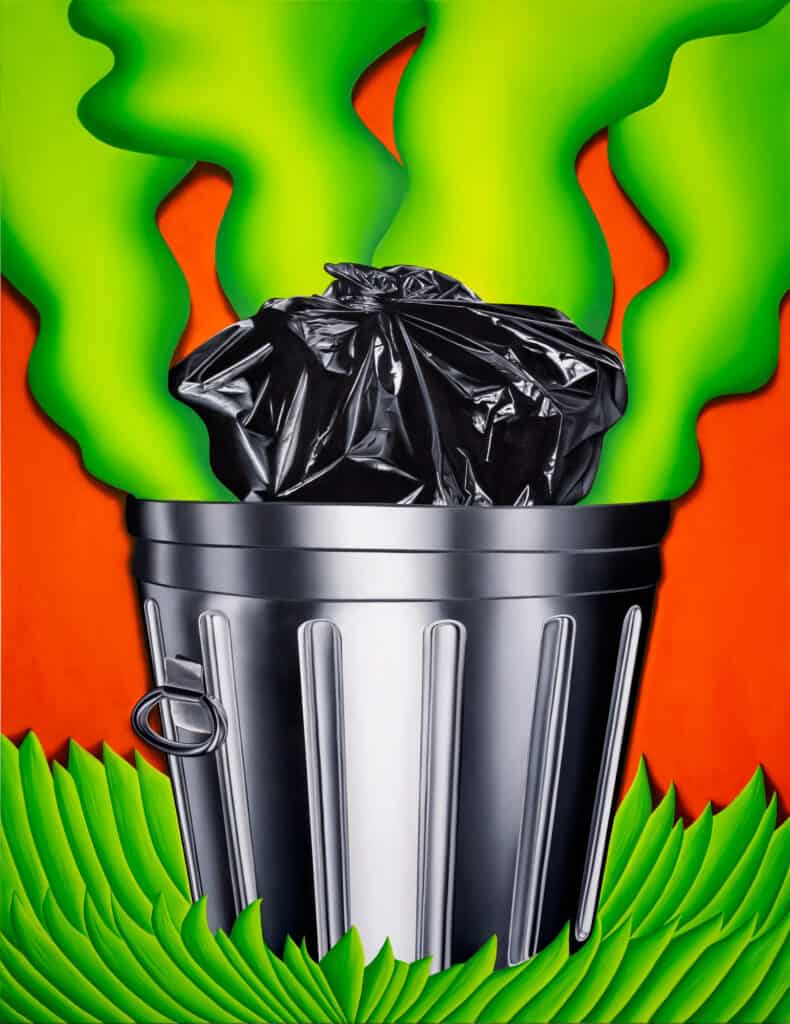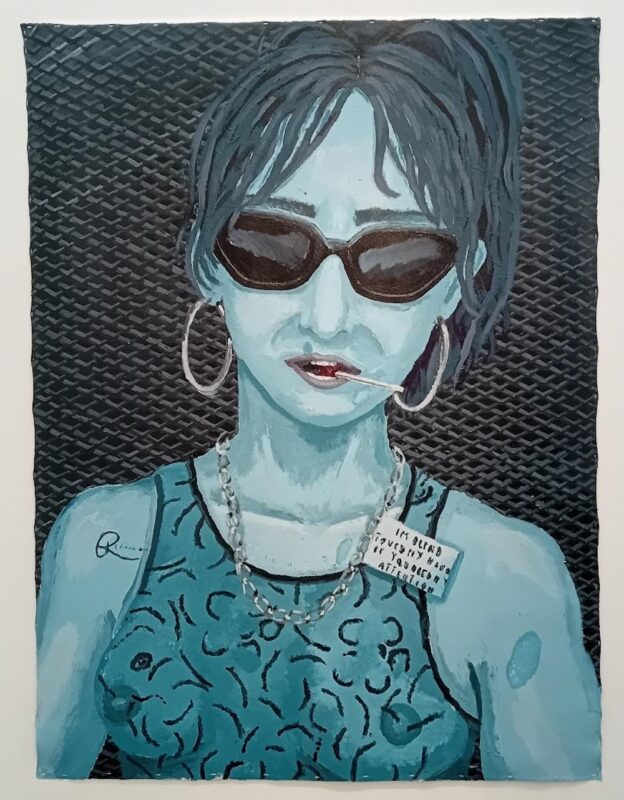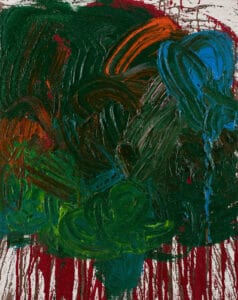
Smoked Ham is the Brazilian painter Rafa Silvares’ debut solo exhibition at Peres Projects, Berlin. With extreme precision and craftsmanship, Silvares’ works evade narrative or thematic approaches, focusing instead on the sensorial and synaesthetic properties of painting. Nevertheless, the new group of medium and large scale works on view at Peres Projects forms a coherent pictorial repertoire in which images of industrialised objects, domestic utensils and machinery are depicted in the act of generating some kind of organic by-product. Although the human figure is completely absent from these paintings, it is alluded to both through the choice of objects that favours those which function as extensions of the body (a telephone receiver, a straw, or a takeaway foil wrap) and the range of senses they convey (sound, taste, smell, touch, in addition to vision, surely). Beyond that, there is also the fact that all these objects seem to operate without any human intervention, thus becoming themselves anthropomorphised, or even sentient.
The title of the exhibition reflects not only the centrality of the body in these works but also Silvares’ interest in exploring the multiple associations between verbal and visual language in painting, in a complex semiotic game where word and image are constantly being attached to different referents (the thing itself) to generate open-ended meanings. In this context, the ‘smoked ham’ in the title stands for a very particular type of flesh; not the bloody carnage of Soutine or the pulsating entrails of Adriana Varejão, but something whose pleasantly pink appearance appears almost synthetic and whose texture is at once soft and dense, smoked. In other words, a texture that mirrors the effect sought by Silvares in the painstakingly laboured surfaces of his paintings. The artist speaks of his wish to make things seen ‘as if through a filter’ where objects achieve a cosmetic quality in compositions that are structured as smooth fields of colour gradients, vibrations and contrasts.
Figuration, in this sense, is used as a pretext or springboard to work through issues pertaining to the domain of painting rather than a means to fulfil a narrative function. This is not to say that the figures that make it into a composition are gratuitous or random. Rafa Silvares’ works draw on a myriad of references from art history, literature, design, pop culture, and many more; all of which play a part in the construction of his pictorial vocabulary. On the one hand, his work methodology involves collecting images that appeal to him, images of very mundane objects that can be found in any typical middle-class household worldwide and which are devoid of any particular symbolism. In parallel to this, the artist compiles lists of all kinds of stuff that may feed into the paintings: texts, ideas, visual, cultural references, and so forth.
This methodology of selective permeability generates a personal repertoire of disparate references that are drawn together by what he describes as a ‘magnetic pull’. The next step involves a series of studies in colour and composition using both analogue drawings and digital software in order to test the different combinations between figure and background, colour contrast, or the general gestalt of each work. Like such artists as German-Brazilian Eleonore Koch and her distant relative Josef Albers, Rafa Silvares devotes a lot of energy to the careful planning of his paintings, privileging the phenomenological aspect over any specific narrative content that the work may convey. Evidently, the purpose is not to claim a return to the modern belief in the autonomy of art (or painting, for that matter). On the contrary, as a ‘post-neo’ artist (as in Neo-Geo, Neo-Expressionism, or painting after ‘the death of painting’ in general), Silvares’ work is absolutely contaminated not only by everyday stuff but also by the multitude of artistic styles and ideas that preceded him and from which he often picks and mixes freely in his works.
The painting Ham Parade (2021), for example, takes its title from Picabia’s Love Parade (1917); produced in a period when the artist became fascinated with the idea of machines as pictorial sources and created a series of mechanomorphic works in which industrial objects are invested with human qualities. The central figure in Silvares’ painting is made up of a concoction of different types of metallic bits of machinery and utensils assembled together in the shape of a train that cuts across the composition to divide the pictorial plane horizontally. Contrasting with the great mass of black and white gradients, the artist adds a solid ultramarine blue background on the top of the composition and a vibrant fluo yellow at the bottom. This is complemented by a sweeping, sensuous, and extremely soft red and white gradient that appears as the smoke coming out of the train chimney that extends to the right-hand side of the canvas. In Silvares’ incongruous scenery, however, the smoke has a fleshy (ham-like) quality; it is some type of weird organic excrescence produced by the machine whose warm, smooth appearance contrasts dramatically with the coldness and hardness of the industrial objects. Like Picabia’s machines, the figure in Ham Parade seems to have acquired anthropomorphic qualities not only due to its mysterious self-functioning mechanism (i.e. a thing that moves without human intervention) but also because it appears to be producing something laden with human feelings of desire, sensuousness, or seductiveness. It is worth noting, however, that Silvares’ interest in machines as pictorial sources does not coincide with early modern ideals of industrialisation as progress. In his works, machines appear rather as signs of a hyper consumerist world on the verge of environmental apocalypse.
In the work Smoothsayer (2021), a set of four metal straws are shown sprouting from a juxtaposition of frothy planes in gradients of green, brown and grey against the vibrant red gradient in the background. Again, Silvares looks at a historical precedent for inspiration in the construction of the composition; this time the reference being De Chirico’s use of architectural elements and dramatic shadows in order to create a succession of flat planes in the same picture. The viscous drops placed at the tip of the straws suggest that the object’s function has been somehow subverted: instead of being a tool for consumption of liquids, the straw appears instead to be actually consuming the painting itself. Indeed, Silvares refers to Smoothsayer as a self-consuming painting, bringing to the table ideas around the contemporary status of art as a desirable commodity. In this case, it is the painting that is voraciously consuming its own deliciousness, seduced by its own image and caught in a never-ending narcissist-fetishist loop.
More than criticising the financial or speculative aspects of the art world today, Silvares seems to want to get to the bottom of our relationship to art – and to images -, probing what has triggered the centuries-long human impulse to make and experience art. The largest work on view at Smoked Ham is a mural-size triptych titled Late Night Booty Call (2021). The composition traverses the whole extension of the three canvases, starting on the right panel with what looks like a crumpled piece of foil typically used for take-away food that issues a small flame which increasingly grows in size to take up the entire surface of the left panel. The massive yellow and red gradient is rendered in a similar manner as the other organic volumes produced by disparate objects in Silvares’ paintings: soft, sensuous, and above all highly ambiguous. In this particular instance, the gradient can only be read as a flame in relation to the figure, which provides enough contextual information for the viewer to identify it as such. But there is also something highly hedonistic about the volumes that make up this flame; the image becoming suggestive of a pile of luscious human bodies (torsos, buttocks, legs) entangled in an orgy of the senses; adding another possible layer of meaning reinforced by the title. Ultimately, Late Night Booty Call humorously suggests that perhaps the source of all desire – whether to placate a hunger bout by getting a takeaway falafel after a drunken soirée or being hit by an urgent sexual drive in the middle of the night – is, pathetically, the same.
But what are those gradient masses that recur in all the paintings presented in this exhibition and what function do they fulfil in the composition? From a technical viewpoint, they are precisely executed, their sleek surface not showing any signs of mark-making that could reveal the artist’s subjectivity. From an art historical perspective, a more obvious correspondence could be made with the work of Brazilian painter Tarsila do Amaral, whose treatment of curvaceous figures as synthetic sculptural volumes (via Léger) loosely resonate with Silvares’ forms. In contrast with the cold and precise quality of the industrial objects in these pictures, the gradient masses are amorphous, uncontrolled substances that invoke the different senses. But not only that. The work Annunciation (2021) takes as its starting point the famous early renaissance altarpiece by Fra Angelico in which the archangel Gabriel is depicted wearing a glorious pale pink robe adorned with golden embroidery. Silvares’ Annunciation is similarly dominated by a pale pink substance that pours out of a meat grinder and seems to spill out of the edges of the canvas. Despite the obviously distinct subject-matter of these paintings, Silvares’ choice to incorporate a traditional religious reference suggests the desire to attribute a transcendental quality to the fleshy discharge in his own painting. Ultimately, it says more about Rafa Silvares’ indefatigable faith in painting’s ability to deeply affect one’s senses and generate a multiplicity of possible meanings that may change over time. Painting as a thing in itself, freed from the obligation to surpass or destroy what came before, or to illustrate current cultural debates, or to represent something. Words Kiki Mazzucchelli
Rafa Silvares Smoked Ham October 8th–November 19th, 2021 Peres Projects peresprojects.com
Rafa Silvares (b.1984 in Santos, BR) earned degrees in Fine Arts from Fundação Armando Alvares Penteado, São Paulo and in Language and Literature from FFLCH University of São Paulo. His debut solo exhibition, Smoked Ham, is currently on view at Peres Projects, Berlin. He lives and works between London, UK and Berlin, DE.







